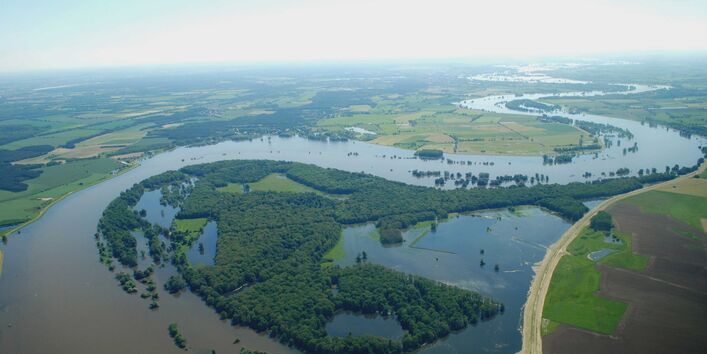More space for rivers
In the past centuries, dikes close to the river banks have cut off many floodplains from the rivers. As a result, the floodplains can no longer absorb and retain floodwaters. Today, only 20% of the natural floodplains remain on the major rivers Rhine, Elbe, Danube and Oder, as well as on the rivers Dosse, Ohre, Unstrut and Schwarzer Elster and on the alpine tributaries of the Danube (BfN 2021). These areas - also called flood retention areas - have an important function in the case of a flood: they buffer the course of a flood wave because they store and retain water temporarily (Figure 1).
An important requirement of the flood regulations of the Federal Water Act (WHG) is to make larger areas available for the overflowing of rivers. This can be achieved, by keeping floodplains free of certain uses (details on this can be found in the guidance documents of the federal states, such as the guidance documents on flood protection and flood management Construction planning law Brandenburg).
In this way, existing retention areas are preserved and new areas can be reclaimed. The designation of a floodplain is not arbitrary. It is based on the natural framework conditions, which are oriented to the extent of a 100-year flood.
Relocating dikes creates flood retention areas. It also makes it possible to naturalise watercourses by giving them more space for self-dynamic development and reconnecting floodplains to the river. By doing so, important ecosystem services of watercourses (e.g. habitat for many animal and plant species, biodiversity hotspots, nutrient filters, water reservoirs, carbon sinks) can be strengthened. Measures of natural flood protection are therefore well compatible with the objectives of watercourse and nature conservation and have many synergies. The online platform "Renaturation of Running Waters" provides information for potential initiators of renaturation projects. The ecological benefits of polders, which can be selectively flooded during floods, lag significantly behind the synergies of dike relocations.

If water is retained in the area because the river has room to spread out, the flood wave is less steep. However, the discharge rate remains constant (hatched areas are the same size). Figure according to the Bavarian State Office for the Environment.

